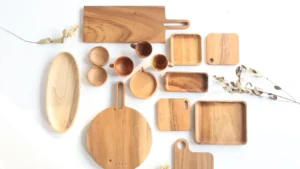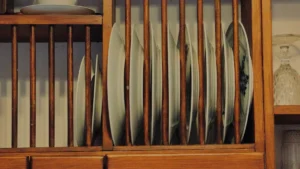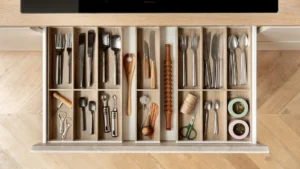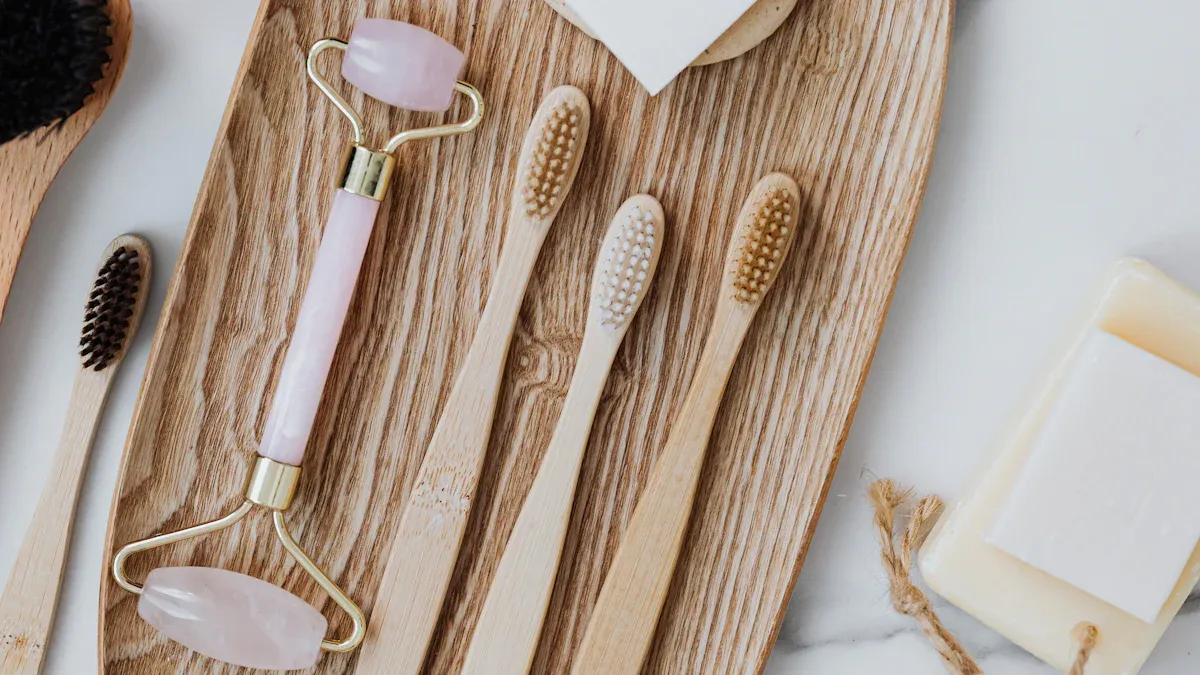
If you’re looking to make your kitchen more eco-friendly, bamboo food containers are a great choice. Bamboo grows quickly and requires minimal space or chemicals, making it a sustainable option. In China alone, there are over 837 species of bamboo spread across 7.56 million hectares, and each year, around 150 million tons of bamboo are harvested for consumer products like bamboo food containers. By choosing bamboo food containers, you’re selecting a material that benefits both your health and the environment.
The Environmental Impact of Plastic Containers
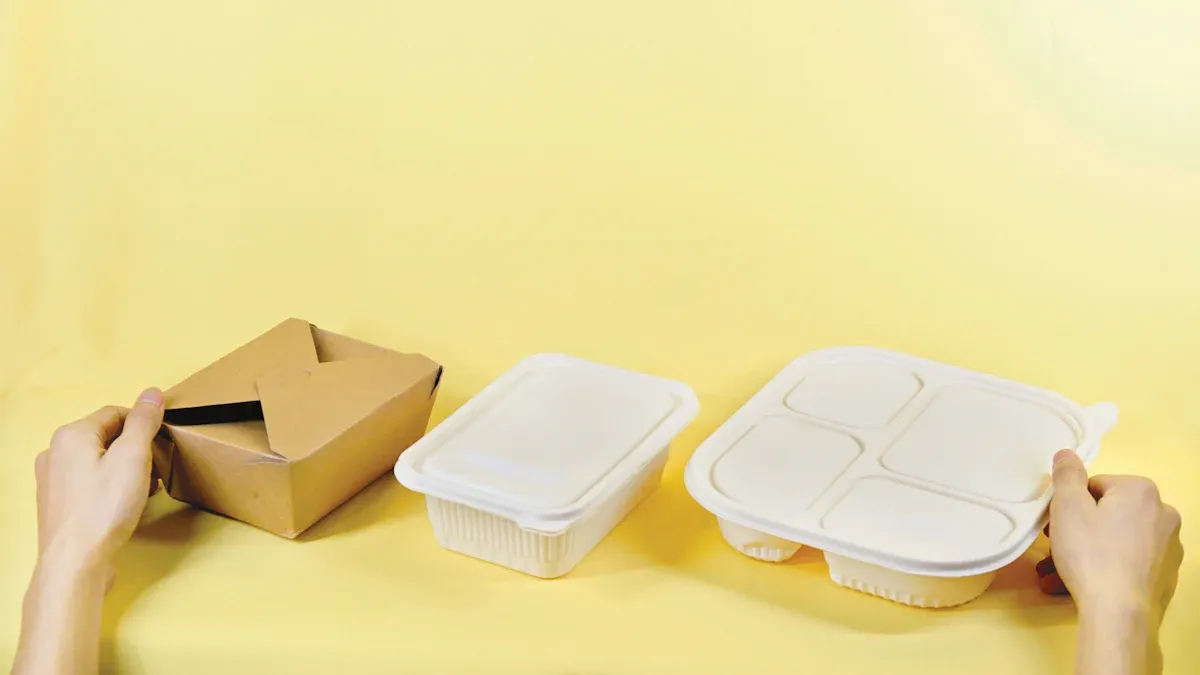
Plastic Pollution in Landfills and Oceans
You see plastic everywhere—at home, in stores, and even outside. Most plastic containers end up in landfills or oceans. In fact, about 50% of plastic waste goes straight to landfills, while 0.5% finds its way into the ocean each year. That adds up to 1 million tonnes of plastic entering the ocean annually. Only 9% of plastic gets recycled, and 25% is mismanaged, which means it can easily become litter or pollution.
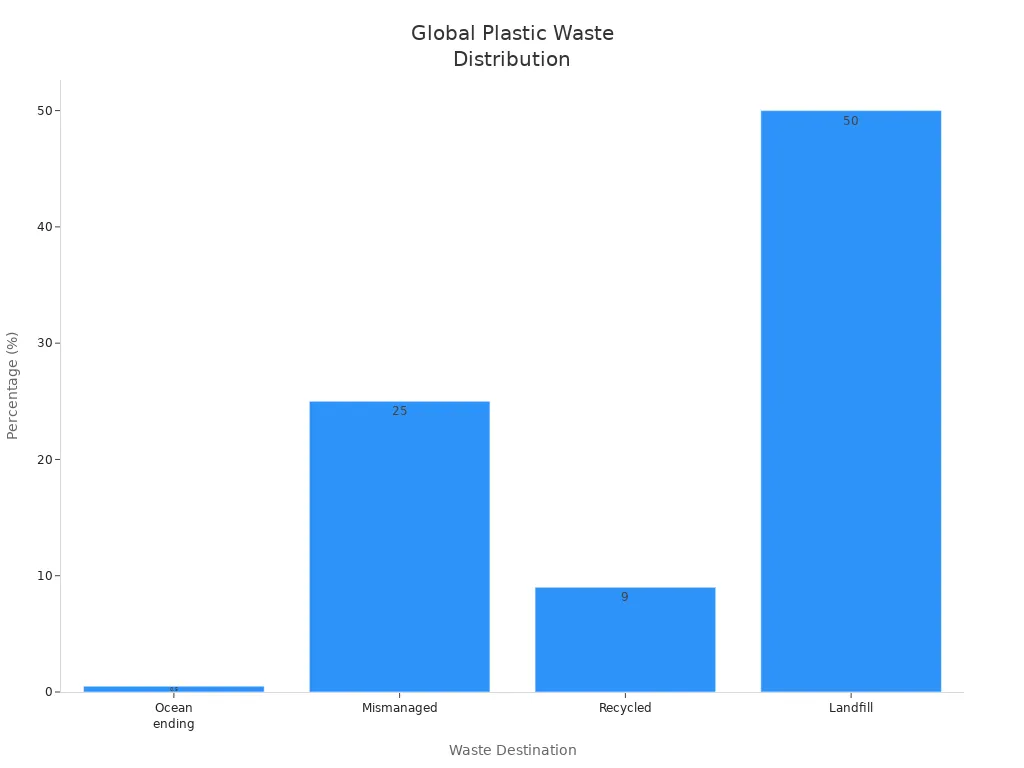
Plastic pollution sticks around for a long time. Take a look at how long different plastics last:
| Type of Plastic | Decomposition Time (Landfill) | Decomposition Time (Marine) |
|---|---|---|
| Plastic Bags | 10 to 20 years | 10 to 20 years |
| Plastic Straws | 100 to 500 years | N/A |
| Plastic Bottles | Up to 450 years | Up to 450 years |
| Fishing Gear | N/A | Up to 600 years |
| Plastic-Coated Paper Milk Cartons | Around 5 years | N/A |
| Diapers | Up to 450 years | N/A |
You can see why plastic pollution is such a big problem. It doesn’t go away quickly.
Harmful Chemicals and Health Risks
When you use plastic containers for food, you might not realize what’s inside them. Many plastics contain chemicals that can leach into your food. Some of these chemicals include phthalates, bisphenols, and parabens. These chemicals can cause health problems like hormone changes, oxidative stress, and even increase your risk for certain diseases.
Did you know? A study found microplastics in carotid plaques, which can raise health risks for your heart.
Here’s a quick look at some chemicals found in plastic containers:
| Function | Chemical group |
|---|---|
| Plasticizer | Chlorinated paraffin, phthalate, bisphenols |
| Biocide | Carbamate, phenolic, paraben |
| Colorant | Azo dye, pigment |
| Stabilizer | Tin, organophosphate, hindered phenol |
| Surfactant | Nonylphenol, octylphenol, PFAS |
Researchers found 906 chemicals in plastic packaging, with 148 linked to human toxicity. About 74% of plastic extracts triggered at least one toxic effect.
The Challenge of Recycling Plastic
You might think recycling solves the problem, but it’s not that simple. Most plastic food containers don’t get recycled. For example, only 29% of PET bottles and jars are recycled, and just 8.7% of all plastics make it through the recycling process.
| Type of Plastic Container | Recycling Rate (%) |
|---|---|
| PET bottles and jars | 29.1 |
| HDPE natural bottles | 29.3 |
| Overall plastics | 8.7 |
Many plastics are hard to sort and clean, so they end up as waste. This makes plastic pollution worse and keeps landfills full.
Bamboo Food Containers: A Sustainable Alternative
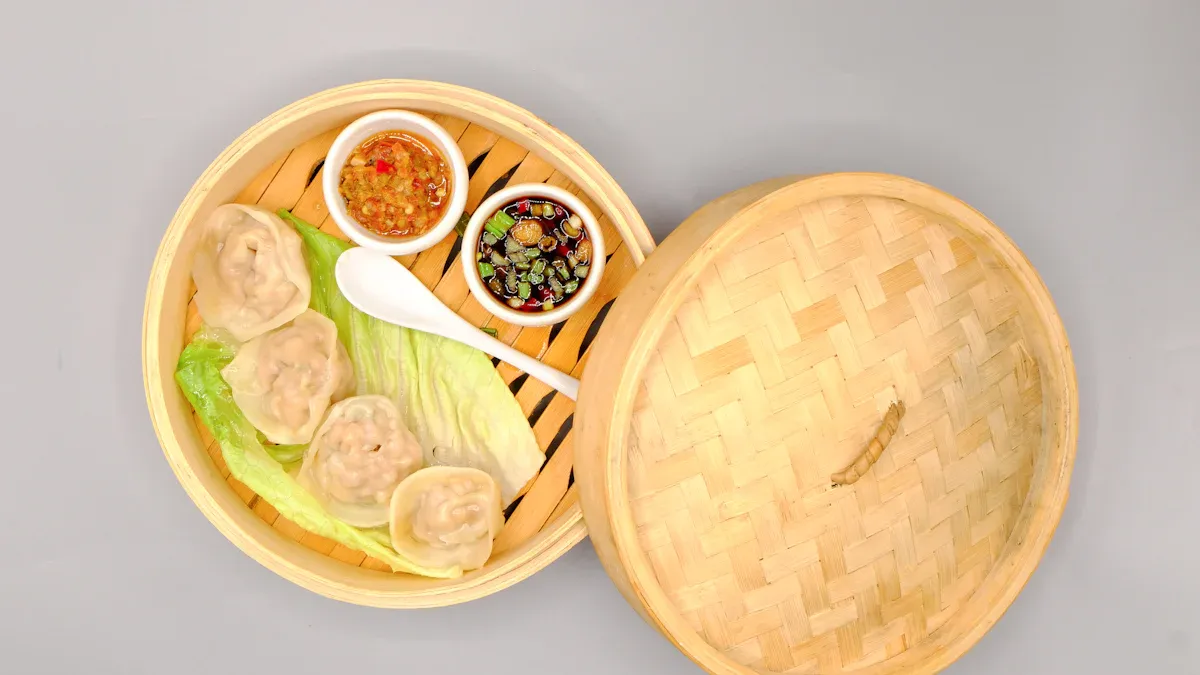
Fast-Growing and Renewable Resource
You might wonder what makes bamboo food containers stand out from other options. Bamboo grows incredibly fast. Some species can shoot up by three feet in just one day! This means you get a renewable resource that keeps coming back year after year. Bamboo doesn’t need much water to thrive. Unlike cotton, which uses a lot of water and often needs pesticides, bamboo grows strong with very little help. You don’t have to worry about harmful chemicals in the soil or water. When you choose bamboo food containers, you support farming that protects the planet and uses land wisely.
Tip: Bamboo is a grass, not a tree. It regrows after harvesting, so you never run out!
Natural Biodegradability
If you care about waste, bamboo food containers are a smart pick. These containers break down quickly in compost. Take a look at how fast bamboo disappears compared to other materials:
| Material | Biodegradation Time | Environment |
|---|---|---|
| Bamboo & Straw Fiber | 2–6 months | Natural environment |
You don’t have to wait years for bamboo to break down. In just a few months, your old containers can return to the earth. This helps you cut down on landfill waste and keeps your kitchen eco-friendly.
Minimal Processing and Low Carbon Footprint
Making bamboo food containers uses less energy than making plastic ones. Bamboo needs little fertilizer, no pesticides, and very little water. This means less pollution and fewer greenhouse gases. Studies show that bamboo products can even have a negative carbon footprint. They store more carbon than they release during production. Here’s why bamboo is a great choice:
- Bamboo is a rapidly renewable resource.
- It has a low carbon footprint compared to plastic.
- Bamboo cultivation does not harm the environment.
When you pick bamboo food containers, you choose sustainable alternatives that help fight climate change. You get a product that’s good for you and the planet.
Comparing Bamboo Food Containers and Plastic Containers
Environmental Footprint
When you look at the environmental impact, the difference between bamboo food containers and plastic containers is huge. Plastic waste has piled up to 7 billion tonnes since 1950. This waste sticks around for hundreds of years, polluting land and water. You can see the damage everywhere.
Bamboo food containers offer a much greener choice. Here’s why:
- Bamboo is renewable and grows super fast—up to 2.91 feet each day.
- You don’t need harmful chemicals to grow bamboo.
- Bamboo containers break down naturally and enrich the soil.
- Bamboo can absorb 2 tons of carbon dioxide in seven years, which helps fight climate change.
Plastic containers, on the other hand, just keep adding to pollution. They don’t break down easily and can harm wildlife and people for generations.
Tip: When you choose bamboo, you help close the loop in nature. Your containers return to the earth instead of filling up landfills.
Durability and Everyday Use
You want containers that last and keep your food fresh. Plastic containers are everywhere because they’re lightweight and tough. But they have a downside. Over time, plastic holds onto food smells and stains. You might notice yesterday’s spaghetti sauce still lingering in your lunchbox.
Bamboo food containers handle stains and odors better. Plastic tends to trap smells and flavors, making it hard to get rid of them. Bamboo containers, especially those with silicone linings, seal tightly and keep food fresh. You can use them for snacks, lunches, or leftovers. They look stylish on your counter or in your fridge.
Here’s a quick comparison:
- Plastic containers: Good for durability, but they stain and hold odors.
- Bamboo containers: Resist stains and odors, especially with silicone seals. They look great and work well for daily use.
Note: If you want a container that keeps your food fresh and doesn’t smell, bamboo with a silicone lining is a smart pick.
Safety for Food Storage
Safety matters when you store food. You want to know what touches your meals. Some plastic containers contain chemicals that can leach into your food, especially when you heat them or store acidic foods. Chemicals like melamine and formaldehyde can cause health problems if they get into your food.
Let’s look at what experts say about safety:
| Safety Standard | Description |
|---|---|
| Advisory Status | The FSA and FSS advise against using plastic food containers containing bamboo due to health concerns. |
| Health Risks | Chemicals like formaldehyde and melamine can leach into food, especially with hot or acidic foods. |
| Disposal Recommendation | Consumers should dispose of these products or use them for non-food purposes. |
| Market Status | These products should not be sold in Great Britain as they are considered unsafe. |
Recent tests found that 32% of bamboo-plastic containers released melamine into hot drinks like lemon tea and orange juice. Formaldehyde showed up in all tested bamboo dinner sets for kids in one study. Long-term exposure to these chemicals can lead to kidney damage or stomach problems.
You can feel confident using pure bamboo food containers that don’t mix in plastics. They don’t contain harmful chemicals, so you can store your food safely.
Eco-Friendly Benefits of Bamboo Food Containers
Reduced Waste and Compostability
You probably want to cut down on kitchen waste. Bamboo food containers make this easy. When you finish using them, you can compost them instead of tossing them in the trash. Unlike plastic, which can sit in landfills for hundreds of years, bamboo breaks down much faster. In a natural environment, bamboo fiber can biodegrade in just 2 to 6 months.
Not all composting facilities accept every type of food container. Take a look at how bamboo fiber compares to other materials in municipal composting:
| Material Type | Percentage Accepted |
|---|---|
| Uncoated paper/paperboard | 83% |
| Bamboo fiber | 29% |
| Wax-lined paper/paperboard | 21% |
| Sugarcane/bagasse fiber | 17% |
| Clay-coated paper/paperboard | 13% |
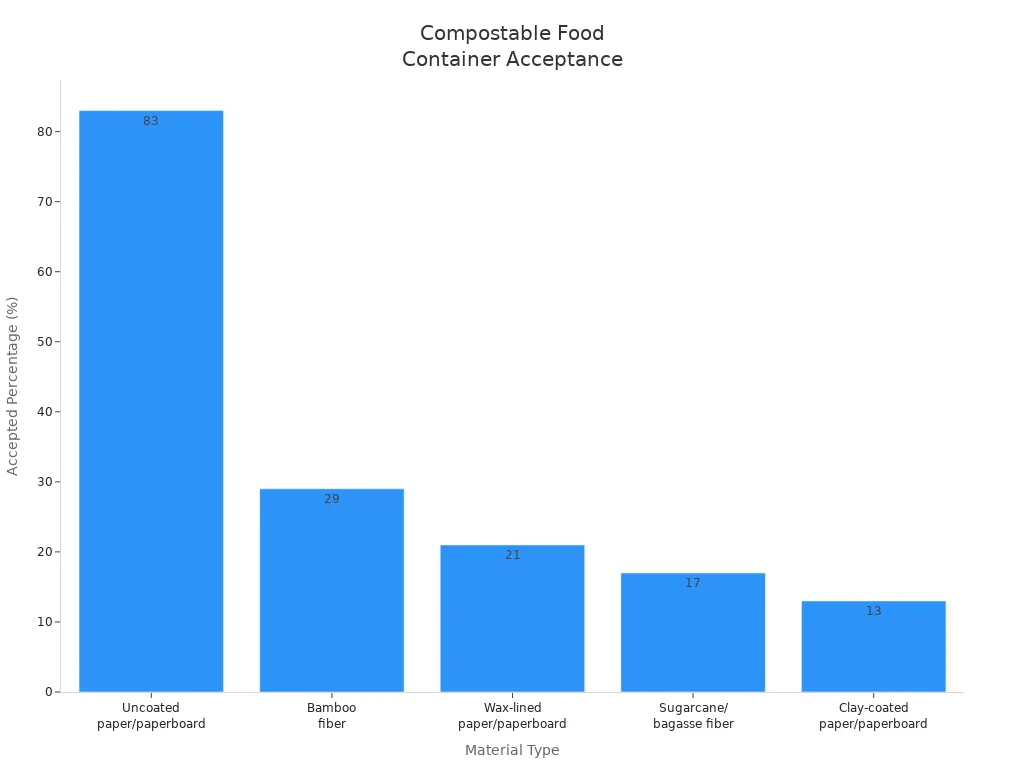
You can see that bamboo fiber is accepted in almost a third of municipal composting programs. This means you have a real chance to keep your kitchen waste out of landfills. When you choose bamboo food containers, you help reduce the pile of trash and support a cleaner planet.
Tip: If your city has a composting program, check if they accept bamboo fiber. You might be able to turn your old containers into rich soil for gardens!
Non-Toxic and Chemical-Free
You want your food storage to be safe. Bamboo food containers give you peace of mind because they do not contain the harmful chemicals found in many plastics. You never have to worry about toxic fumes or dangerous substances leaching into your meals.
Here’s what you avoid when you use bamboo:
- No harmful chemicals like phthalates or bisphenols.
- No toxic fumes released into the air.
- No need for pesticides or fertilizers during bamboo growth, thanks to its natural antibacterial and anti-fungal properties.
- Bamboo is biodegradable and naturally fights bacteria.
You can feel good knowing that your food stays fresh and safe. Bamboo grows quickly and doesn’t need chemical help, so you get a product that’s clean from start to finish. You also help keep your home and the environment free from toxins.
Note: Bamboo’s natural antibacterial properties help keep your food fresher for longer.
Stylish and Functional Design
You don’t have to give up style for sustainability. Bamboo food containers look modern and natural, fitting right into any kitchen. The smooth finish and warm color make them stand out on your countertop or in your fridge.
You’ll find that these containers are not just pretty—they’re practical, too. Many come with tight-fitting lids, sometimes made with silicone, to keep your food fresh. They resist stains and odors, so you won’t smell yesterday’s lunch every time you open the lid. You can use them for snacks, leftovers, or even as lunchboxes for school or work.
Here’s why people love using bamboo food containers:
- They look great in any kitchen.
- They’re lightweight and easy to carry.
- They stack neatly, saving space in your cabinets.
- They work for hot or cold foods.
Switching to bamboo food containers lets you organize your kitchen with products that are both beautiful and eco-friendly. You get the best of both worlds—function and fashion.
Making the Switch to Bamboo Food Containers
How to Choose Quality Bamboo Food Containers
When you shop for bamboo food containers, you want to make sure you pick the best ones for your kitchen. Look for containers that are safe, strong, and made with the planet in mind. Here’s a quick guide to help you:
| Criteria | Description |
|---|---|
| Safety | Make sure the containers are free from harmful chemicals or toxins. |
| Quality | Check that the containers feel sturdy and work well for daily use. |
| Sustainability | Choose products made in an eco-friendly way, using responsible practices. |
You can also look for certifications. Some brands, like Bambu, have USDA Organic certification, which means no harmful pesticides or fertilizers were used. Other certifications include Cedar Grove, DEBIO, ASTM-D6400, and European Standard EN 13432. These show that the containers are compostable and safe for the environment.
Tip: Always check for labels or certifications on the packaging before you buy.
Care and Maintenance
Taking care of your bamboo food containers helps them last longer and keeps them looking great. Here’s how you can do it:
- Hand wash with mild soap and warm water.
- Avoid soaking the containers for a long time.
- Dry them well after washing to prevent mold.
- Use natural cleaners like vinegar and water, or add a few drops of lemon or tea tree oil for extra freshness.
- For tough stains, try a salt scrub or rice water.
- Apply food-safe mineral oil every few months to keep the bamboo smooth.
| Aspect | Bamboo Containers | Plastic Containers |
|---|---|---|
| Cleaning Method | Hand wash, avoid soaking | Dishwasher safe |
| Care Requirements | Apply mineral oil sometimes | Low maintenance |
| Longevity | Biodegradable, returns to earth | Lasts for years, not eco-friendly |
Integrating Bamboo Food Containers into Your Daily Routine
Switching to bamboo food containers is easy when you build good habits. Try these simple steps:
- Set up a spot in your kitchen just for bamboo containers.
- Spend 10-15 minutes each day putting food and snacks into your bamboo storage.
- Wipe down your containers once a week to keep them clean.
- Every few months, check your system and see if you need more containers or a new setup.
You’ll find that using bamboo containers makes your kitchen look neat and helps you stay organized. Plus, you’re making a choice that’s better for the planet!
Switching to bamboo food containers is a smart move for your kitchen and the planet. You help by reducing plastic waste, supporting a cleaner environment, and keeping your food safe. Bamboo breaks down in months, not centuries, and even releases more oxygen than trees. Plus, the market for bamboo products keeps growing as more people choose eco-friendly options.
When you pick bamboo, you join a movement that protects your health and supports a greener future.
FAQ
Are bamboo food containers safe for storing all types of food?
Yes, you can safely store most foods in bamboo containers. They do not contain harmful chemicals like BPA or phthalates. For liquids or very wet foods, choose containers with a silicone seal to prevent leaks.
Can I put bamboo food containers in the microwave or dishwasher?
You should not use bamboo containers in the microwave or dishwasher. High heat and water pressure can damage them. Hand wash with mild soap and warm water to keep them looking great.
How long do bamboo food containers last?
With proper care, bamboo food containers can last for several years. Avoid soaking them or exposing them to extreme heat. If you notice cracks or warping, it’s time to compost them.
Are bamboo food containers really compostable?
Yes! Bamboo containers break down in compost within 2–6 months. Make sure your local composting program accepts bamboo fiber. If not, you can compost them at home in a backyard bin.
Do bamboo food containers affect the taste or smell of food?
No, bamboo does not transfer flavors or odors to your food. You get fresh-tasting meals every time. If you notice any lingering smells, wash with vinegar and water for a quick refresh.


